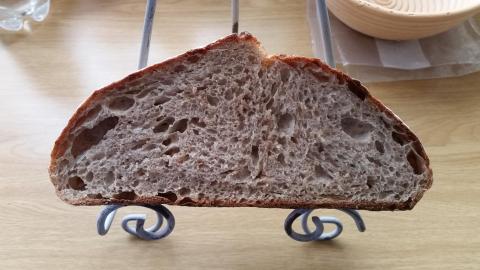May 26, 2020 - 12:53am

Fridged autolyse
Help PLEASE!
I am attempting my first sourdough after succeeding with my first starter. I ran out of time with the recipe I am following. The recipe required me to refresh my starter and leave for 3 hrs and autolyse the flour for 30mins. The next stage was to add the starter and fold for 4 sessions every 30mins and then to bulk rise for 4-6 hrs. My starter took longer to double in size. So at 22:00 hrs I decided to place the autolyse in the fridge overnight and restart in the morning, which is now. I have brought the autolyse back up to room temp,and the starter is refreshed and doing good.
So the big question is, have I spoilt the flour and wasted my time, should I dump the mix and start again, or carry on as normal?


You made a smart move to refrigerate the autolyse, which slowed enzymatic activity.
Paul
Thanks Paul,
I did go ahead, although not sure what I was doing. LOL Very chuffed with the outcome.
I left the cold dough for 1hr to get to room temp and then preshaped without any extra S&F and left for 30 mins. The dough was very stiff, I then proved in a basket for 2 hrs. The recipe asked for 4hrs but did a poke test and decided to go for it. All looked good but when cooled I cut into it and there were some holes but not large ones and the crumb appeared dense. Although I must say it smelt and tasted great. Toasted it was fantastic.
Would the crumb have had larger holes had I left to prove for longer? I was scared of over proving.
Appreciate your feedback.

Regards
Victor
Victor, that is your first sourdough bake? Wow what a great success! As someone who has been over proofing recently I understand your fear of over proofing. I think these could have gone a bit longer, but really they look great.
Benny
Thanks Benny for the positive feedback, really appreciate it.
Regarding using the starter. After refreshing and we get it working, should the starter be stirred then added or use the top section that is far gassier when added to the autolyse?
Stay safe over there.
I can’t say that I’ve ever read that it is necessary to stir the levain prior to being added to the dough. I’ve never bothered to stir it but it certainly does end up getting mixed while spooning it out.
Stay safe as well.
Benny
Hi Bennie, I must confess that the breads on view were baked in a cast Dutch oven not on a stone, so not so impressive with the pot helping the rise/spring. I will try the next on a stone to see if they rise as well. Most of the bread I have baked on a stone with steam tray never get a good oven spring and ends up 2" thick. I assume not enough gluten structure from under kneading's. What you think?
There are so many reasons that we can get flat breads instead of well risen. Yes lack of gluten development and poor structure are just two. Over proofing, poor shaping with lack of surface tension are another two. I’ve been baking in my dutch oven recently but that doesn’t necessarily guarantee good oven spring, but it helps make the steamy environment that is needed for good oven spring. Baking on a stone can give great oven spring so long as you can create enough steam in your oven and that you’ve developed your dough well enough to achieve it.